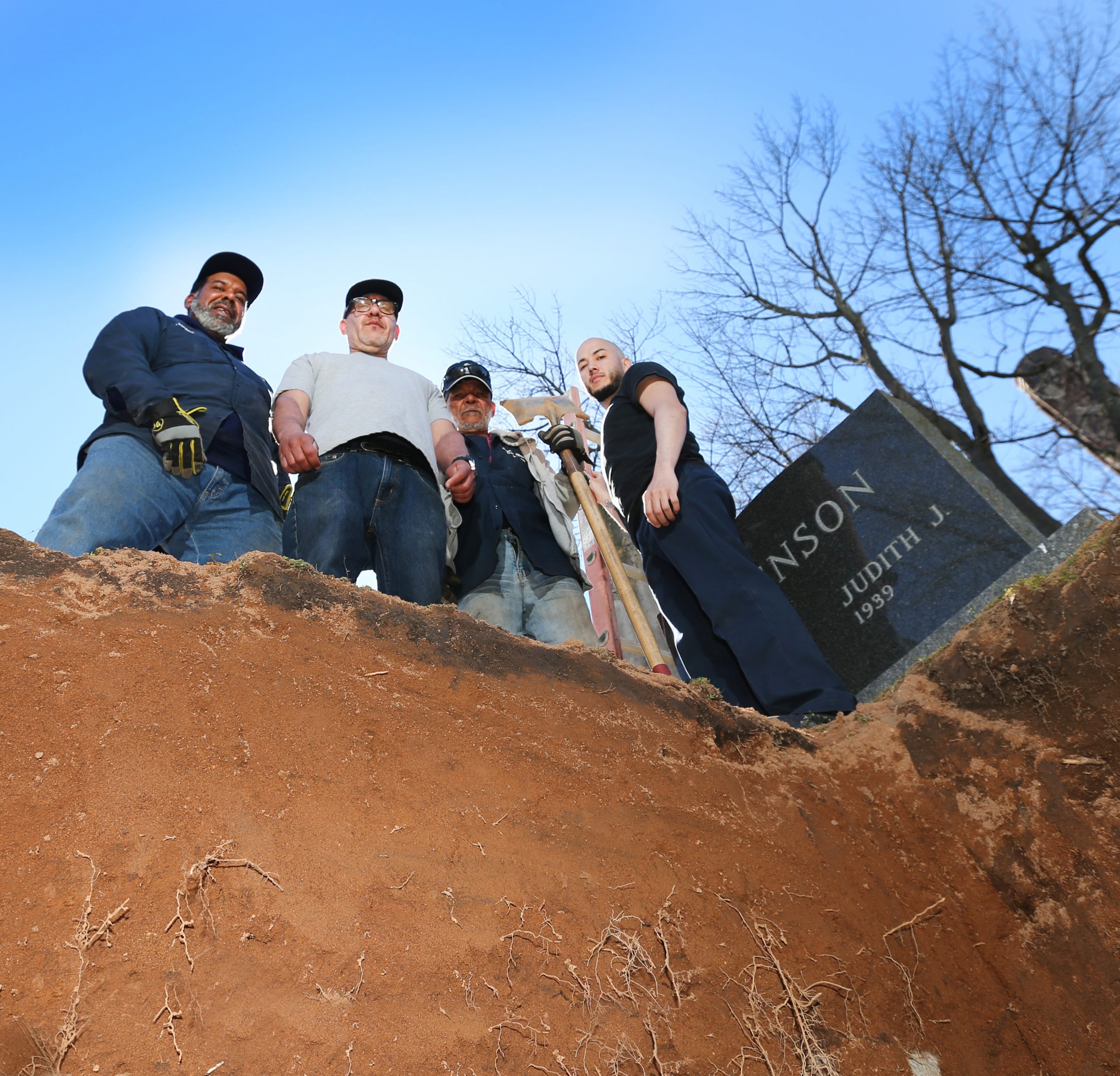For a place set aside for the dead, Grove Street Cemetery is crowded with the living.
The first officially chartered cemetery in the country, Grove Street remains a vital part of the New Haven landscape, accepting dozens of new burials a year and hosting hundreds of visitors every day.
Since the first burial took place there in November 1797, that landscape has drastically changed, but Grove Street remains the same, right down to how they dig the graves – one shovelful at a time.
About 50 times a year, a small crew using shovels and pickaxes dig into the earth for about four hours, creating a near-perfect rectangle three feet wide and eight feet long. A final resting place.
As tours stroll the cemetery or people have their lunch and a quiet phone conversation in the shade of an oak, the sound of metal scraping into dirt echoes, as it did two centuries ago.
“Everything is so close, we can’t get machines between the gravestones,” says superintendent Seeley Jennings. Also, the age of many of the existing graves means they might collapse under the weight of machinery that’s used in most graveyards. “So, we dig them by hand.”
Twelve months a year, whether it’s 95 degrees or well below freezing, rain or snow, the shovels bite the earth.
“Junior,” who has been digging for seven years, thinks the winter is the toughest. “It’s because the ground is so frozen, we need to use a jackhammer to break through,” he says. “After that, it’s back to the shovels the rest of the way. A winter grave could take eight hours to dig.
“Some new people dig one grave, and never come back,” he says. “It looks easy, but it’s not easy.”
The men who dig the graves are also the groundskeepers, caring for the entire cemetery – landscaping, plowing, sweeping, and keeping Grove Street Cemetery looking well-kept and dignified.

Day to day, they maintain the final resting places of about 14,000, including cotton gin inventor Eli Whitney; band leader Glenn Miller; the father of American football, Walter Camp; Civil War Union Army Brigadier General Amos Beebe Eaton; David Humphreys, aide de camp to General George Washington; dictionary publisher Noah Webster; and Andrew Hull Foote, the naval officer who in 1862 infamously ended the rum ration in the United States Navy. He died shortly thereafter. There are also 14 former presidents of Yale University buried here.
Grove Street was created when 32 prominent New Haven citizens, led by James Hillhouse, decided to create a new public burial ground for the city after the yellow fever epidemic of 1794-1795 left the common burial ground, at what is now Center Church on the Green, crowded and unsightly. Moving quickly, the southeastern area of the cemetery was laid out in September of 1796.
As the first planned cemetery, Grove Street introduced several ideas that changed the way people viewed death and burial. With conscious design, it offered permanently owned family plots, a potter’s field for the destitute or unknown, ornamental plantings, and named streets and avenues, including Laurel and Willow and Sycamore.
Land was purchased in 1814 to double the cemetery’s size after all existing plots had been sold. In 1845, the cemetery was finished being enclosed with a wrought-iron fence, and the familiar sandstone, Egyptian Revival style arch was dedicated with a flourish in July 1845. The chapel was built in 1872.
That first grave was for Martha Beardsley Townsend, who was born in Stratford in 1752 and died in New Haven on Nov. 7, 1797. The remains of her son Lucius, who had died many years before at the age of 17 months, were taken from the Green and re-buried beside his mother. Their graves are at 13 Linden Ave.
Foreman Edwin Torres has been a groundskeeper and gravedigger at Grove Street for 11 years, and says, “I love digging graves…it’s peaceful.”
But like life, each new day digging a grave is different. “Some are easy, some are hard.” Some go smoothly, and “…some are filled with roots and rocks,” he says.
Eric Andino of Bridgeport has only been digging graves and working at Grove Street Cemetery for about a year, but the peacefulness and the work have left a mark. “Looking at all the graves makes me thankful,” he says. “Every day we wake up, we’re fortunate.”
They know a little of the history of who each grave is for, and there’s a certain amount of solemnity to the work. Sometimes he thinks, “This was a person who was alive a week ago.”

The men agree that the hardest part is just getting started, those first few shovelfuls.
As they encounter stones, they are removed. As they hit roots, they are cut. As they take turns stepping into the ever-deepening hole, the air gets a little cooler, the smell of the earth a little sweeter.
And it does smell different, like when you dig into your garden on a spring morning, and the ground smells moist, almost fresh. Only it completely surrounds you. It’s not an unpleasant place to be, especially when you know you can reach for that old wooden ladder and just climb out.
Superintendent Jennings says, “You have to know what you’re doing; you have to edge it off so it’s nice and square.”
To start, “I lay down a metal brace that’s three feet by eight,” he says, and the gravediggers then use that as a template after they probe the ground to make sure the earth is clear underneath. Then they dig down about four-and-a-half to five feet deep.
That’s all? Four-and-a-half feet?
“They haven’t dug six feet deep in 100 years,” Jennings explains. “They didn’t have concrete vaults in the 1700s and the 1800s, and back then, grave robbing was a very big deal. They were stealing cadavers and selling the bodies to medical schools. The grave robbers [often] worked alone, and if the body is buried six feet deep, that’s a lot of digging for one grave robber. It would take him all night.”
Also called “resurrectionists,” body snatchers were careful not to take anything from the grave but the body, because stealing only the corpse was not considered a felony in the 18th and early 19th centuries in the United States. The courts had ruled that a dead body had no owner.
But today, Grove Street is peaceful 24/7, with no ghoulish silhouettes digging against a midnight sky.
“Hundreds of people a day walk through here,” says Jennings. “There are probably 25 [regulars] who come in every day and walk the cemetery.”
It’s a fascinating, calm, beautiful place.
Occasionally, a visitor will get a little too comfortable, buried in a book, lost in their headphones, or just falling asleep. They’ll go to leave and find the place deserted of the living and the gates locked tight. “We have a phone number on the office door,” says Jennings. “When they call, we’ll come and let them out.”
Sometimes during a dig, the curious will stop and watch. The docents will usually keep the tour groups at a distance, but the diggers don’t mind the company.
“Willie” has been digging at Grove Street Cemetery for about 25 years. When asked how many graves he’s dug, he just shakes his head and says, “A lot.”
He wears a red bandana around his head, and in his calloused hand is a burning Newport. He says he digs a grave now the same way he did 20 years ago. Then he looks out over the sea of tombstones, laughs, and says, “The same as 100 years ago.
Photography by Stan Godlewski








More Stories
Over 50, Underestimated: The Grandfluencers Redefining Age on Social Media
Building Resilient Businesses: Strategies for Success
Summer Means Convertibles